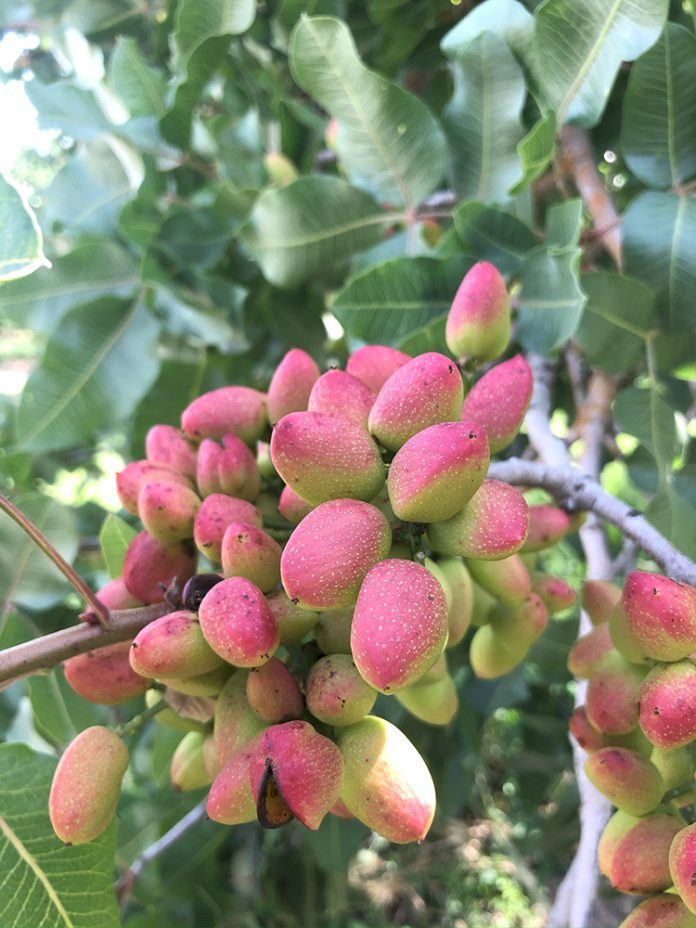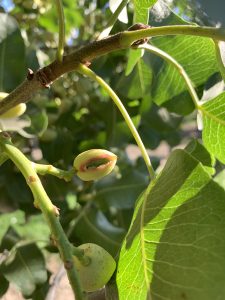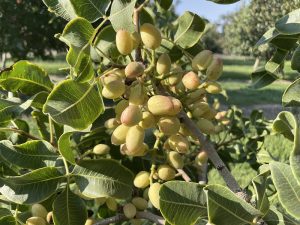
Pistachio hull integrity during the growing season is critical to preserving kernel quality. Hulls naturally degrade when nuts ripen, signaling harvest time. How long the hull remains intact, even though the nut is ripening, is hull integrity.
The hull of the pistachio is called the epicarp (exocarp and mesocarp). It is about 1/16-inch thick and adheres tightly to the hard inner shell until the nut is ripe. It undergoes specific physical and chemical changes at nut maturity.
Those changes were outlined in a Pistachio Day presentation by Barbara Blanco-Ulate, UC Davis faculty in Plant Sciences. Blanco-Ulate and UC Davis Plant Sciences faculty Giulia Marino note that little is known about how environmental differences in growing conditions affect pistachio ripening and NOW susceptibility. Since 2019, they have been conducting research funded by the California Pistachio Research Board (CPRB) to better understand how temperature drives the annual timing and extent of hull degradation in pistachio. Their research is also aimed at characterizing specific nut characteristics that can predict the extent of hull degradation in pistachios. These studies may allow better understanding of how navel orangeworm (NOW) respond to hull integrity.
Blanco-Ulate said her CPRB-funded project led her to rethink nut growth stages. She noted shell hardening and kernel growth happen at the same time. Hull ripening and kernel maturation start once the kernel reached the maximum size. There is also a peak in volatiles that happens just prior to hull ripening. Shell split occurs in parallel with hull softening. Hull softening and hull coloration to red are reliable biomarkers of hull breakdown. Blanco-Ulate explained that biomarkers are molecular or physical signatures that can be measured in the field to anticipate large physiological changes like hull ripening and breakdown. Pistachio hull breakdown occurs after nut ripening and leads to higher nut susceptibility to insect infestation and fungal decay.

Ripening Process
Pistachio nuts can display early or ‘pea split’ or normal ripening. The early splits are more likely to become infested by NOW several weeks prior to normal maturation, USDA-ARS Entomologist Joel Siegel said. NOW egg laying on normally maturing nuts does not increase until the hulls begin tearing and breaking down.
“Something is happening physiologically with early splits. Hulls can stick to the shell and expanding nuts tear the hull. When the hull breaks down, it releases a chemical that attracts NOW,” Siegel said.
Hull breakdown is part of the ripening process, but tree stress or metabolic factors can cause early tears which will cause loss of crop quality. This “damage by other means” on grade sheets includes necrosis or shell defects which cause otherwise good kernels to be diverted to shelling stock.
Pistachio nuts that are ripening normally have shells that split under the hull. At this stage, hulls that begin to have a puffy or soft appearance and slip from the shell, signaling nuts are ready for harvest, generally around the end of August depending on orchard location. The trouble with recognizing crop maturity, Siegel noted, is that in a cluster of nuts, not all will reach maturity at the same time.
At the processor, hulls on the mature nuts slip off, but the hulls on less-than-mature nuts adhere to the shell.

Components of Hull Integrity
There are physiological and environmental components to hull integrity. Recognizing the physiological signs of hull breakdown at nut maturity can help growers develop management plans to ensure nut quality and time harvest to minimize NOW damage and increase nut quality.
Pistachio variety can also determine hull integrity. Blanco-Ulate’s research showed a faster hull breakdown in the Golden Hills variety compared to Kerman. Also, Golden Hills had the highest level of VOCs earlier in the season, while Kerman VOCs peaked two weeks later at a much lower level. This faster rate of hull degradation could make nuts more susceptible to insect damage and fungal growth and is the reason growers of this variety are urged to harvest early.
Bloom time and spring temperatures during early nut growth also impact blanking and nut quality at harvest. Late-bloom nuts have higher incidence of blanks and filled nuts without splits. Blanco-Ulate’s research showed with normal bloom, 18% blank. Late bloom had 37% blanks. Normal bloom produced 94% shell split while late bloom in some locations only reached 55% shell split. Late-bloom nuts have significantly harder hulls and softer shells. She noted it is not always the case that kernel expansion forces shell splitting. It appears to be more than physical force, she noted.
Water and Nutrition
In the field, Setton Pistachio plant manager Jeff Gibbons said experience shows water and nutrition management set the stage for hull integrity during the growing season.
“I’ve been preaching this to growers for several years now, healthy trees play a part in hull integrity and that keeps navel orangeworm out,” Gibbons said.
Although the winter of 2022-23 provided plenty of water for pistachio orchards, that is not the case every year. Gibbons said keeping trees watered during dry winters and not deficit irrigating at bloom will result in better hull development from mid-April to June 1. Over application of nitrogen and insufficient calcium and potassium in the root zone can also play a part in fruit development.
Weather during hull development is also a major factor in hull integrity, Gibbons said. In his experience, hot, dry weather during that time can compromise pistachio hulls. Cool, moist conditions can result in stronger hulls. This year, he said the weather cooperated and he expects better hull integrity throughout the growing season.
Zack Raven, farm manager at Keenan Farms, said as harvest nears, hull integrity has their attention. Keeping up with crop ET, particularly during heat spells, can help keep hulls intact. In addition to NOW damage, he said adhering hulls cause staining on shells. Stains on shells can mean loss of quality bonuses for growers.
Hull degradation and shell split are likely driven by interactions between tree physiology and environmental conditions, Houston Wilson, UCCE specialist and entomologist at UC Riverside, wrote in his research for CPRB. Better understanding of these interactions could allow for development of management strategies to influence these processes, opening the way for growers to better predict and even manage hull integrity and shell split.










